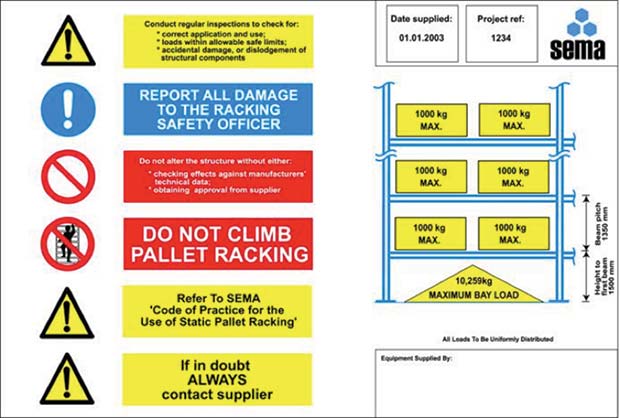The first question we have this month is looking for clarification on what the current requirements are for Load notices. Then we look at the best way for pedestrians in warehouse locations to avoid contact with FLT’S.

Meeting load notice requirements
Q. I have attached a photograph of the current load notice we are using. Could you please advise if this load notice meets the current standard requirements for signs such as these?
A. Requirements for load notices are given in the EN15635 and in the SEMA Load notices code – the requirements of these documents are virtually identical.
The SEMA load notices code was published in 2004 (before 2004, load notices had a different format) and EN15635 in 2008. Your image shows the date supplied as 2009 so it would seem reasonable to assume that your load notice should comply with one or both of these documents.
The illustration below shows an example load notice for an adjustable pallet racking application (other types of storage equipment are similar)
General safety information is shown on the left hand side and information that is particular to that installation is shown on the right.
The key items of information on the design criteria are shown on the right hand side which are:-
• Number of pallets per pair of beams
• Maximum load per pallet
• Maximum bay load – this is the total load that can be carried in a bay (excluding pallets on the floor)
NOTE: it may not necessarily equal the number of beams multiplied by the load per level.
• Height to first beam level
• Beam pitch
• Loads to be uniformly distributed
The number of pallets and load per pallet can sometimes be combined to give a maximum load per pair of beams i.e. in this instance from the image you supplied it would appear to be 2000kg.
The SEMA logo can only be used on a Load Notice when the storage equipment has been manufactured and supplied by a SEMA member.
Separating Pedestrians from Flt’s
Q. I am interested in any ideas / products that could be used to warn FLT operators when pedestrians are working within aisles between racking, or to prevent access by FLTs until the aisle is clear of pedestrians.
A. There are a number of different products on the market which address this issue. These vary from the simple traffic cone placed on the floor at the entrance to an aisle to a collapsible metal gate with a padlock such as has been seen in some retail environments where fork lift trucks are operating while the public are in the store.
We have also seen chains that are hooked across the ends of the aisle while people are present and hinged red and white arms, rather like the old fashioned railway signal, fixed to the corner upright so it can be dropped down across the aisle entrance.
All of these possibilities boil down to a specific risk assessment looking at the congestion, speed of operation etc. of the particular warehouse which will perhaps then point to the best way of solving the problem.
SEMA is delighted to be working with WLN on the storage Question and Answer Column which is published in WLN on a monthly basis. On the WLN website is a list of previously published columns which we hope you find useful.
Please note that SEMA Users Club members also have access to a comprehensive range of additional storage related questions and answers.
A date for your diary
The 2015 SEMA Safety Conference has been scheduled for Thursday, 5 November; the venue will be the National Motorcycle Museum, Solihull.
SEMA Technical Enquiries
We hope you find the above articles, and those in previous editions, interesting. If you have a query send it to us by fax or email and we will do our best to have it answered by one of our technical experts.
Rack Safety Awareness and Inspection Courses
SEMA runs a one-day safety course on Rack Safety Awareness and Inspection. These courses are aimed at end users, giving an in-depth look at the need for inspections, how to conduct an assessment and what actions to take when this is completed. These courses are normally held at the SEMA headquarters but arrangements can be made to hold them at the delegates’ premises.
Approved Rack Inspectors Qualification
This qualification is aimed at professionals who conduct rack surveys as an integral and significant part of their duties. It involves delegates in undertaking an in-depth SEMA Course, together with an examination and practical assessment. CPD will be an important part of the qualification, demonstrating to end users that SEMA Approved Inspectors maintain a high professional standard.
SEMA Publications
SEMA has 26 publications in stock – Codes of Practice, ‘Guides’ and European documents – all of which are available from our Offices.
SEMA USERS Club
SEMA runs a USERS Club designed to be of benefit to purchasers and users of storage equipment. Members receive newsletters, access to specialised events and discounted rates on publications and codes of practice.





Comments are closed.